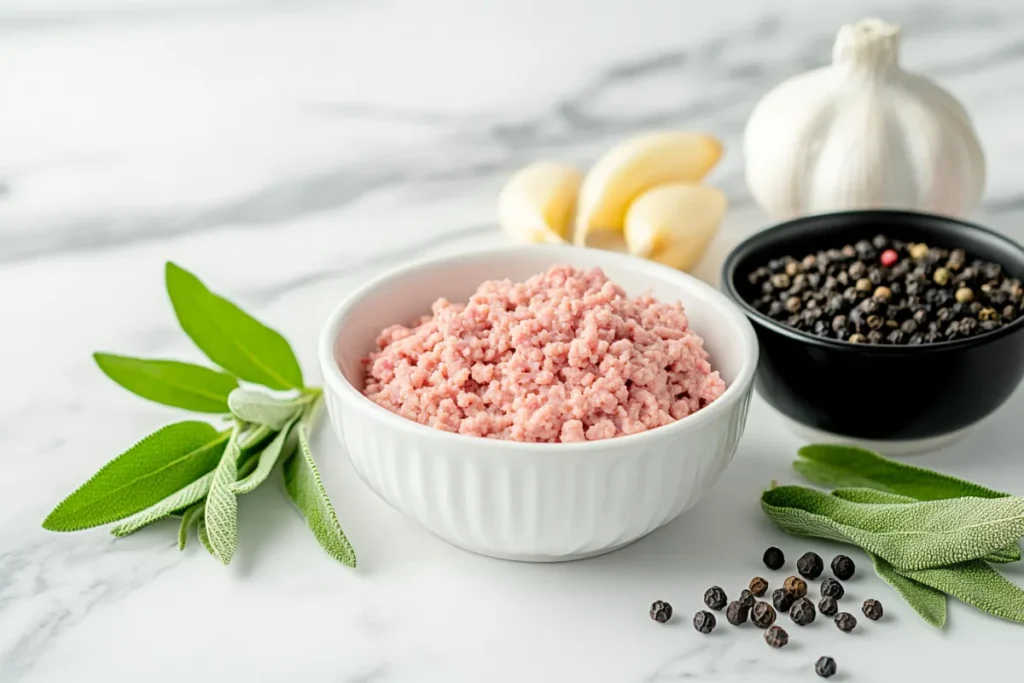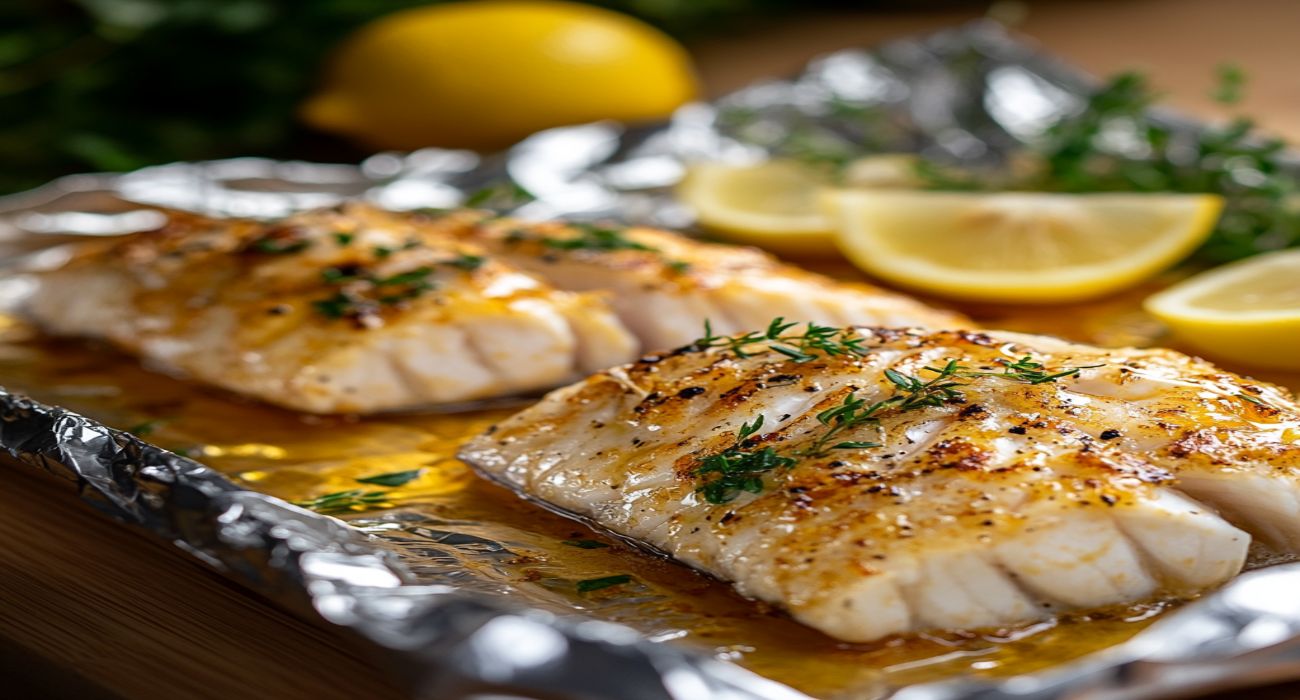What is turkey sausage made out of? This question comes up often for those curious about healthier alternatives to traditional pork sausage. Turkey sausage has become a popular option, thanks to its leaner profile and versatile flavor. But what exactly goes into making it, and how does it differ from other sausages?
In this article, we’ll explore the key ingredients of turkey sausage, the production process, and the various types available on the market. We’ll also touch on its nutritional value, health benefits, and tips for cooking with it. Whether you’re a first-time buyer or a longtime fan, you’ll learn everything you need to know about turkey sausage. Let’s dive in!
Understanding Turkey Sausage
Definition: What is Turkey Sausage?
At its core, turkey sausage is simply sausage made from ground turkey instead of traditional pork or beef. Like other sausages, it’s seasoned with a blend of herbs, spices, and sometimes other ingredients to achieve a flavorful profile. Turkey sausage can be sold in various forms, including fresh, pre-cooked, smoked, or frozen, making it a versatile addition to any meal.
What sets turkey sausage apart is its reputation as a leaner, healthier alternative. With significantly less fat than pork sausage, turkey sausage appeals to health-conscious individuals looking to enjoy flavorful dishes without compromising their dietary goals.
Ingredients Commonly Found in Turkey Sausage
So, what is turkey sausage made out of? While the primary ingredient is ground turkey, there’s more to it than just meat. Here’s a breakdown of what you’ll typically find in turkey sausage:
- Ground Turkey: This is the base ingredient, often using a mix of dark and white turkey meat for optimal flavor and texture.
- Seasonings: Common spices include sage, black pepper, garlic powder, paprika, and thyme. These give turkey sausage its signature savory taste.
- Binders and Fillers: Some varieties may include breadcrumbs, rice flour, or eggs to hold the sausage together.
- Preservatives: Commercially produced turkey sausage may contain nitrates or nitrites to enhance shelf life and maintain color.
Homemade turkey sausage is a great option if you want to avoid additives, as you can control the ingredients and seasonings to fit your preferences.
Why Choose Turkey Sausage Over Pork Sausage?
One of the biggest reasons people switch to turkey sausage is its lower fat and calorie content. A typical serving of turkey sausage contains about half the fat of pork sausage, making it ideal for those watching their cholesterol or calorie intake.
Additionally, turkey sausage is versatile and takes on the flavors of its seasonings well, making it an excellent ingredient for a variety of dishes. Whether you’re preparing a hearty breakfast or a savory pasta dish, turkey sausage can provide a flavorful and healthy alternative to traditional sausage options.

Core Ingredients of Turkey Sausage
Primary Ingredient: Ground Turkey
The most important ingredient in turkey sausage is, unsurprisingly, ground turkey. This meat forms the foundation of the sausage and is usually made from a combination of white and dark turkey meat. The blend ensures that the sausage has a good balance of flavor and moisture since turkey breast alone can be too lean and dry for sausage-making.
Turkey sausage made with dark meat tends to have a richer, more savory taste, while sausages made with leaner white meat have fewer calories and less fat. When buying turkey sausage, checking the packaging will often reveal the meat blend used.
Seasonings and Spices in Turkey Sausage
The next essential component of turkey sausage is the seasoning blend. Turkey itself has a mild flavor, which makes it the perfect canvas for a variety of spices. Some of the most common seasonings used in turkey sausage include:
- Sage: Adds a classic earthy flavor often associated with breakfast sausages.
- Black Pepper and Garlic Powder: Create a savory and slightly spicy kick.
- Paprika: Provides both color and a subtle smoky undertone.
- Thyme or Fennel Seeds: Deliver a herbaceous or slightly licorice-like flavor, popular in Italian-style sausages.
The seasoning mix is what gives turkey sausage its distinctive taste and allows it to mimic the bold flavors of traditional pork sausage.
Additives and Binders: What Else is Included?
Now, what is turkey sausage made out of beyond turkey and spices? Many store-bought options include additional ingredients to improve texture, flavor, and shelf life. These may include:
- Binders: Ingredients like breadcrumbs, rice flour, or egg whites help the sausage hold its shape.
- Preservatives: Nitrates and nitrites are commonly added to extend shelf life and preserve color, especially in pre-cooked or smoked varieties.
- Salt: Enhances flavor and acts as a natural preservative, but can sometimes lead to higher sodium levels.
If you’re looking for a cleaner option, consider nitrate-free or organic turkey sausage, which minimizes the use of these additives.
In Part 3, we’ll dive deeper into the different types of turkey sausage and how their ingredients vary depending on the style—fresh, pre-cooked, or flavored.
Types of Turkey Sausage and Their Ingredients
Fresh Turkey Sausage Ingredients
Fresh turkey sausage is raw and requires cooking before consumption. Its ingredients are usually straightforward: ground turkey, a blend of seasonings, and minimal binders or fillers. Since it’s not pre-cooked or preserved, fresh turkey sausage often has a more natural flavor and texture.
For example, breakfast turkey sausage links or patties are often sold fresh, flavored with sage, black pepper, and garlic for a classic savory profile. Homemade fresh turkey sausage is a great choice if you want to avoid preservatives or control the amount of salt in your food.
Pre-Cooked and Smoked Turkey Sausage: What’s Inside?
Pre-cooked turkey sausage is a convenient option for quick meals, as it only needs reheating. However, this variety may include more preservatives, such as nitrates or nitrites, to extend shelf life. Pre-cooked turkey sausages often feature additional flavoring agents, like smoke extracts or caramel coloring, to enhance their appearance and taste.
Smoked turkey sausage undergoes a smoking process that adds a deep, smoky flavor. Common ingredients for smoked varieties include turkey meat, salt, sugar, and spices like paprika or chili powder for a slightly spicy edge.
Flavored Varieties: Breakfast, Italian, and Spicy Turkey Sausage
The ingredients in flavored turkey sausages vary depending on the type. For instance:
- Breakfast Turkey Sausage: Typically flavored with sage, thyme, and a hint of maple syrup for sweetness.
- Italian Turkey Sausage: Includes spices like fennel seeds, oregano, and red pepper flakes for a zesty, Mediterranean-inspired taste.
- Spicy Turkey Sausage: Packed with bold seasonings like cayenne pepper, paprika, and chili flakes for those who love a kick of heat.
Flavored turkey sausages are a great way to add variety to your meals, from pasta dishes to breakfast bowls. Each style brings a unique flavor profile, ensuring there’s something for everyone.
How is Turkey Sausage Made?
The Production Process of Turkey Sausage
So, what is turkey sausage made out of and how is it created? The production process of turkey sausage can vary depending on whether it’s made at home or mass-produced in a commercial setting.
In factories, turkey sausage starts with raw turkey meat, which is ground into a fine texture. Depending on the recipe, a combination of dark and white turkey meat is used to ensure the sausage is flavorful and juicy. Once the meat is ground, seasonings like sage, garlic, and black pepper are blended in, along with any additional ingredients like binders or preservatives.
For pre-cooked or smoked turkey sausage, the mixture is then stuffed into casings (often made from natural or synthetic materials) and either cooked or smoked to lock in flavor and increase shelf life. Fresh turkey sausage, on the other hand, is sold raw and must be fully cooked before eating.
Homemade turkey sausage follows a simpler process. Ground turkey is mixed with spices and shaped into patties or stuffed into casings, providing a fresher alternative without artificial additives.
Differences Between Homemade and Store-Bought Turkey Sausage
Homemade turkey sausage is all about control—you decide what is turkey sausage made out of, allowing you to skip unnecessary fillers or preservatives. It’s perfect for those who want a cleaner, more natural product.
Store-bought turkey sausage, however, offers convenience. While it may contain preservatives like nitrates or nitrites, many brands now offer healthier options labeled as “nitrate-free,” “low-sodium,” or “organic.” These can be a time-saving solution when you’re in a rush but still want to enjoy turkey sausage as part of a meal.
If you’d like more recipes for homemade alternatives, check out our chicken breast recipes for inspiration on preparing lean, flavorful proteins.
Health Considerations for Turkey Sausage
Is Turkey Sausage Actually Healthy?
Many people ask, “What is turkey sausage made out of that makes it healthier?” The answer lies in its lean protein content and reduced fat levels. Compared to pork sausage, turkey sausage typically contains fewer calories and less saturated fat, making it a heart-healthy option. Additionally, its high protein content supports muscle growth and keeps you feeling full longer.
However, not all turkey sausages are equally healthy. Some pre-packaged versions are high in sodium, which can pose health risks when consumed in excess. If you’re trying to lower your sodium intake, look for options labeled “low-sodium” or consider making your own turkey sausage at home.
Sodium and Preservatives: A Health Concern?
While turkey sausage is often seen as a healthy alternative, the addition of preservatives like nitrates and nitrites in many commercial varieties can be a downside. These compounds are used to extend shelf life and maintain color, but they’ve been linked to health concerns when consumed in large quantities.
Similarly, the high sodium content in some turkey sausages can lead to issues like high blood pressure or water retention. To minimize these risks, opt for nitrate-free turkey sausage and check the sodium content on the nutrition label. As a rule of thumb, look for products with less than 400 mg of sodium per serving.
Comparing Nutritional Value with Other Sausages
When comparing turkey sausage to pork, chicken, or plant-based sausages, turkey sausage often stands out as a leaner, healthier choice. Here’s how it stacks up:
- Pork Sausage: Higher in fat and calories, with around 15-20 grams of fat per serving. Turkey sausage is a better option for reducing fat intake.
- Chicken Sausage: Similar in fat and protein content, but turkey sausage often has a richer, heartier flavor due to the dark meat.
- Plant-Based Sausages: Cholesterol-free and lower in fat, but they lack the natural protein and nutrients found in turkey sausage.
For a well-rounded diet, turkey sausage is a fantastic choice as long as you select high-quality options or prepare it at home.

Cooking with Turkey Sausage: Tips and Recipe Ideas
Best Cooking Methods for Turkey Sausage
When it comes to cooking, what is turkey sausage made out of can determine the best preparation methods. Since turkey sausage is leaner than pork sausage, it cooks quickly and can dry out if overcooked. To avoid this, use medium heat and avoid overcrowding your pan or grill. Here are some common ways to cook turkey sausage:
- Pan-Frying: Heat a non-stick skillet with a little oil and cook turkey sausage for 5-7 minutes per side until browned. For crumbled sausage, stir frequently to ensure even cooking.
- Grilling: Preheat your grill and cook turkey sausage links or patties over medium heat. This method adds a smoky flavor that complements the seasoning.
- Baking: For a hands-off method, bake turkey sausage at 375°F for 20-25 minutes, turning halfway through. This is ideal for cooking large batches of sausage links.
- Sautéing: Combine turkey sausage with vegetables like bell peppers, zucchini, or onions for a quick, one-pan meal.
Always ensure turkey sausage reaches an internal temperature of 165°F to confirm it’s fully cooked and safe to eat.
Recipes Featuring Turkey Sausage
Turkey sausage is a versatile ingredient that works in a variety of dishes. Here are some recipe ideas:
- Turkey Sausage Breakfast Bowl: Combine sautéed turkey sausage crumbles with scrambled eggs, sweet potatoes, and spinach for a high-protein start to your day.
- Pasta with Turkey Sausage: Toss cooked turkey sausage with whole-grain pasta, marinara sauce, and steamed broccoli for a quick, healthy dinner.
- Stuffed Bell Peppers: Fill halved bell peppers with a mix of turkey sausage, quinoa, and diced tomatoes, then bake until tender.
- Turkey Sausage Stir-Fry: Sauté sliced turkey sausage with veggies and soy sauce for a colorful, nutrient-packed meal.
No matter how you use it, turkey sausage adds flavor and protein to any recipe without overwhelming your dish.
FAQs About Turkey Sausage
What is Turkey Sausage Made Out Of?
Turkey sausage is primarily made from ground turkey, which may include both white and dark meat for a balance of flavor and moisture. To enhance the taste, a mix of spices such as garlic, sage, and black pepper is typically added. Depending on the brand or recipe, it may also include binders like breadcrumbs or rice flour, and preservatives like nitrates or nitrites in store-bought varieties.
If you prefer a cleaner option, consider homemade turkey sausage, where you have full control over the ingredients.
Is Turkey Sausage 100% Turkey?
Not always. While some turkey sausage products are made entirely from turkey meat, others may include fillers, additives, or small amounts of other meats like pork to enhance flavor. Always check the label to ensure you’re purchasing a product that aligns with your dietary preferences. Brands that advertise “all-natural” or “100% turkey” are your best bet for a cleaner product.
Does Turkey Sausage Contain Pork or Other Meats?
Most turkey sausage is made exclusively from turkey, but certain brands may mix in small amounts of pork fat or other meats to improve texture and flavor. This is particularly common in smoked or flavored varieties, so it’s crucial to read the ingredient list.
What’s the Difference Between Turkey Sausage and Chicken Sausage?
Turkey sausage and chicken sausage are similar in terms of nutrition, both being leaner alternatives to pork sausage. The main difference lies in flavor—turkey sausage has a slightly richer taste due to the dark meat, while chicken sausage tends to be milder. Both are versatile and can be used interchangeably in recipes.
Final Thoughts on Turkey Sausage
Why Turkey Sausage is a Popular Choice
Turkey sausage has earned its spot as a go-to option for those seeking a healthier alternative to pork sausage. Its lean composition and high protein content make it ideal for maintaining a balanced diet. But what is turkey sausage made out of that makes it so versatile? With ground turkey as its base, paired with flavorful seasonings like sage, garlic, and paprika, turkey sausage brings both taste and nutrition to the table.
Whether you’re using it in breakfast bowls, pasta dishes, or stir-fries, turkey sausage is an adaptable ingredient that complements countless recipes. Plus, its lighter calorie profile and lower fat content are significant advantages for anyone watching their weight or trying to eat heart-healthy meals.
Making Healthier Choices When Buying Turkey Sausage
While turkey sausage is a healthier option, not all varieties are created equal. Some pre-packaged turkey sausages contain additives, fillers, or high sodium levels. To get the most health benefits, opt for nitrate-free or organic versions and always check the ingredient label to confirm the product aligns with your dietary goals.
If you’re wondering what is turkey sausage made out of in cleaner versions, look for minimal ingredients: ground turkey, spices, and natural binders. For an even healthier option, try making turkey sausage at home with fresh ingredients.
Balancing Convenience with Nutritional Value
Balancing Convenience with Health
For busy lifestyles, store-bought turkey sausage offers undeniable convenience. Pre-cooked or frozen turkey sausages can save you time while still providing a lean protein source. However, to maintain a healthy balance, pair these sausages with nutrient-dense sides like steamed vegetables, quinoa, or leafy greens.
When buying store-bought options, remember to evaluate what is turkey sausage made out of. Check for added preservatives, sugar, or artificial flavorings, which can detract from its health benefits. Low-sodium and organic options are widely available for those who want to prioritize quality.
Why Homemade Turkey Sausage is Worth the Effort
If you want full control over the ingredients in your sausage, homemade turkey sausage is the way to go. By using ground turkey, fresh herbs, and your favorite spices, you can skip the preservatives and customize the flavor to suit your preferences.
Making turkey sausage at home ensures that you know exactly what is turkey sausage made out of—just clean, wholesome ingredients. It’s also a great way to experiment with flavors, from spicy blends to sweeter breakfast sausages.
In conclusion, turkey sausage is a delicious and healthy option, whether you choose store-bought or homemade varieties. By keeping an eye on the ingredients and pairing it with fresh, nutrient-packed foods, you can enjoy its benefits while staying on track with your health goals.
Everything You Need to Know About Turkey Sausage: Delicious Recipes, Benefits, and More
Is Turkey Sausage Actually Healthy? A Complete Guide to Nutrition and Benefits

